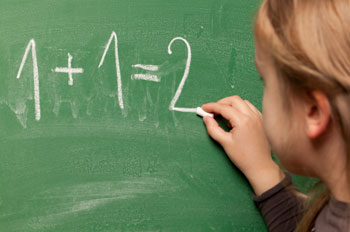Geometry Terms for Middle School Math Students
In middle school, you'll solve geometry problems that ask you to calculate the volume of objects. You'll also learn formulas to help you measure triangles' sides and angles. Keep reading for a list of helpful geometry definitions for middle school students.

Middle School Geometry Terms
Are you ready to learn the geometry terms and formulas you need to know for middle school math? Here's a list of helpful geometry definitions and equations for middle school students.
Types of Angles
- Acute angle
- An angle that measures less than 90 degrees.
- Obtuse angle
- An angle that is greater than 90 degrees.
- Right angle
- An angle with a measure of exactly 90 degrees.
Types of Triangles
- Right triangle
- A triangle that has one right angle.
- Acute triangle
- A triangle with three acute angles.
- Obtuse triangle
- A triangle that has one obtuse angle and two acute angles.
- Equilateral triangle
- A triangle that has three sides of equal length.
- Isosceles triangle
- A triangle with two equally long sides.
- Scalene triangle
- A triangle with three sides that are all different lengths.
Geometry Formulas for Triangles
- Area of a triangle
- You calculate the area of a triangle using the formula A = 1/2 x b x h. The 'b' represents the length of the triangle's base. The base can be any side of the triangle for which you know the length. The 'h' stands for the triangle's height. To find the height, draw a line that is parallel to the base, and that passes through the angle opposite the base. Then, draw a perpendicular line connecting the base to this line. The height is the length of the perpendicular line.
- Pythagorean Theorem
- The Pythagorean Theorem helps you find the length of one side of a right triangle. The equation is a^2 + b^2 = c^2. The 'c' represents the side of the triangle opposite the right angle, which is called the hypotenuse. The letters 'a' and 'b' represent the triangle's other two sides. If you know the lengths of two of the triangle's sides, you can solve this equation to find the length of the third side.
Volume Formulas for 3-D Shapes
Volume refers to the amount of space a 3-dimesional object takes up. To find the volume of regular prisms, you generally multiply their height, length and width. Below are some helpful formulas for finding the volumes of 3-D objects.
- Volume of a cube
- A cube is a 3-dimensional object with equal height, length and width, so its volume formula is V = a^3. 'V' represents the cube's volume and 'a' represents the length of one of its edges. For example, if the cube's sides were all two centimeters, its volume would be eight centimeters squared (2^3 = 8).
- Volume of a rectangular prism
- A rectangular prism is a 3-dimensional shape with parallel sides. To find the volume of one, use the formula V = l x w x h. This formula tells you to multiply the shape's length by its width by its height to calculate the volume.
- Volume of an irregular prism
- Irregular prisms are solid, 3-dimensional objects that don't have straight, parallel edges like rectangular prisms. Their volume is found using the formula V = A x h, where 'A' stands for 'area of the base' and 'h' stands for 'height.'
- Volume for a pyramid
- Pyramids have polygons as bases, and triangular sides that meet at an apex, or single point. The volume formula for any regular pyramid is V = 1/3 x b x h. It's important to remember that here, 'b' is the area of the pyramid's base, not the length of an edge of the base. The 'h' stands for the pyramid's height. This is measured by taking the length of a perpendicular line drawn from the base to the apex.
- Volume for a cylinder
- Cylinders are 3-dimensional solids with circular bases. To calculate the volume of a cylinder, apply the formula V = pi x r^2 x h. The first part of this formula, pi x r^2, tells you the area of the cylinder's base. Multiply that by the cylinder's height, 'h,' to find the volume. Don't forget that the value of pi is 3.14.
Other Articles You May Be Interested In
-
Not Your Father's Algebra As 45 States Look to Math Reform

One plus one will always equal two...but just how students are taught math is going to change. Nearly every state in the country has adopted the Common Core Standards; for math, this means new and more in-depth approaches to teaching the subject. Have we seen the last of traditional algebra and geometry classes?
-
Middle School Blues: A Tough Transition

It's often presumed that the move from middle school to high school is the most challenging and difficult transition students face. Recent studies have shown, however, that the transition into middle school has far more potential to disrupt a student's education.
We Found 7 Tutors You Might Be Interested In
Huntington Learning

- What Huntington Learning offers:
- Online and in-center tutoring
- One on one tutoring
- Every Huntington tutor is certified and trained extensively on the most effective teaching methods
K12

- What K12 offers:
- Online tutoring
- Has a strong and effective partnership with public and private schools
- AdvancED-accredited corporation meeting the highest standards of educational management
Kaplan Kids

- What Kaplan Kids offers:
- Online tutoring
- Customized learning plans
- Real-Time Progress Reports track your child's progress
Kumon

- What Kumon offers:
- In-center tutoring
- Individualized programs for your child
- Helps your child develop the skills and study habits needed to improve their academic performance
Sylvan Learning

- What Sylvan Learning offers:
- Online and in-center tutoring
- Sylvan tutors are certified teachers who provide personalized instruction
- Regular assessment and progress reports
Tutor Doctor

- What Tutor Doctor offers:
- In-Home tutoring
- One on one attention by the tutor
- Develops personlized programs by working with your child's existing homework
TutorVista

- What TutorVista offers:
- Online tutoring
- Student works one-on-one with a professional tutor
- Using the virtual whiteboard workspace to share problems, solutions and explanations